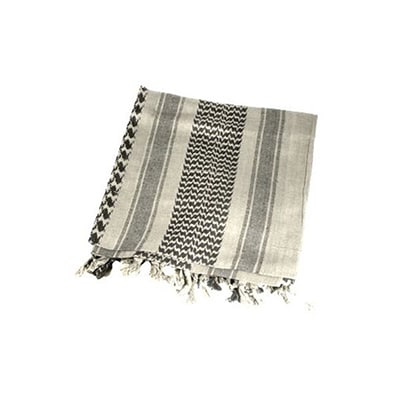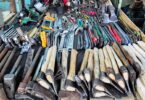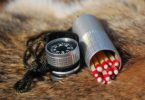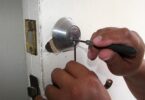The Shemagh, also known as a keffiyeh, is a scarf traditionally worn in the Middle East to protect people from dust, sand, and heat. It was adopted by European and American soldiers fighting there and has become popular across the globe.
A shemagh is not only a type of clothing but also a piece of equipment with many uses. This is a practical piece of gear that can be used in many survival situations, and it is an essential part of many people’s bug-out bags and kits.
How Do I Choose A Shemagh?
A Shemagh can be one of the most practical and valuable pieces of gear you own, so make sure you choose the right one.
There are a few primary considerations when purchasing a Shemagh.
- Material – What type of material do you want? I use either a 100% cotton Shemagh or a cotton wool blend. Cotton will keep you cool and warm while blocking small particles like dust and no-see-ums.
- Size – Many uses require a full-size Shemagh, and a standard size is at least 40 x 40.
- Weight – A light Shemagh for the summer and a heavier Shemagh for the winter is common.
- Quality – Examine the fabric like you would any piece of clothing. Is the stitching tight? Are there unraveling threads? Are there runs or marks? Is the material easy to tear?
Below are three good Shemagh supplies that I like. These are all Etsy stores that make traditional Shemaghs. They are high quality and offer the durability you need in the backcountry.
There are also many Shemagh providers on Amazon. The Shemaghs below are well-made garments in the most common sizes and materials.
The Blackhawk Tactical Shemagh is a 44 x 44, 100% cotton Shemagh. This is a popular, well-made Shemagh that is currently used by both our troops and coalition forces in the middle-east.
This 43 x 41, 100% cotton Shemagh is handwoven and not printed. This is a quality-made Shemagh that the manufacturers stand behind with a one-year warranty. Black is a color I often wear. It blends well and does not stand out.
Rothco's legacy starts in the US, and this quality-made 42 x 42, 100% cotton Shemagh reflects the company's reputation for quality. This is a very popular, no-nonsense Shemagh.
Uses for Your Shemagh
Protection from the Elements
- Fire – During a fire, it’s helpful to have a wet cloth to protect your airway from dust, heat, and smoke. Shemaghs are large pieces of fabric; therefore, they can be used to protect your head, neck, shoulders, and upper arms. Forest fires are becoming more common in the US, and these can be helpful for smoke control and signaling for help.
- Shelter – Place your Shemagh under your sleeping bag for extra protection from the ground. It will not provide the same insulation as a sleeping pad, but it is better than no insulation. It will also help protect a sleeping pad from punctures.
- Sun protection – Stay out of the sun using this lightweight, light-colored fabric around your head and shoulders. This will help you avoid sunburn, dehydration, and heat stroke.
- Dust protection – Like a fire situation, a shemagh will protect you from breathing in debris in windy conditions.
- Snow protection – If you’re caught in a snowstorm, you’ll want to cover up as much of your bare skin as possible to avoid frostbite. A shemagh can help to add some warmth.
- Wind protection – It’s important to keep your face and head covered when you’re out in the elements since up to 30% of your body’s heat is lost through these areas.
General Survival

- Trail marker – The Shemagh can be used as a marker or flag if you’ve gotten lost and need a signal for others to see.
- Firestarter – Pieces of your Shemagh can be used to start fires in emergencies. Cut small cloth pieces from your Shemagh, place them in a tin can and burn them until they become charred and create tiny embers. Then, put them on straw to make a flame and start a fire.
- Weapon – Make a flail from your Shemagh by tying a rock inside of it, or use it as a sling for small game hunting.
First Aid
- Bandage – Cut the Shemagh into small pieces to use as bandages.
- Tourniquet – In addition to an excellent first aid kit, use a shemagh to stop bleeding by tying it above your wound to stop the blood flow.
- Sling – A dislocated limb, a sprain, or a broken bone can be immobilized with an improvised splint created using a shemagh.
- Large wounds (Knees/Legs) – A fall can result in a painful, bruised, and skinned knee that needs to be protected. A scarf works well in these cases, but so does your multi-functional Shemagh. I most recently used mine to protect a badly skinned knee while hiking in the Arizona desert.
Camping
- Towel – Even if not in a life or death survival situation, a shemagh is a practical have as a towel in any camping or travel situation.
- Tablecloth – It is frustrating to find your picnic tables dirty or messy, and a shemagh can quickly solve this problem.
- Potholder. The handles of your pots and pans can give you burns if you don’t have something to wrap them in, and a Shemagh is a good potholder. I use mine often when backpacking and camping.
- Privacy – If you’re caught traveling for longer than anticipated and have to sleep in your car unexpectedly, it is always good to have privacy. Improvise a curtain from your Shemagh.
- Water filter – If you’ve left your water filter at home or don’t have a filtration system, you can easily filter out debris with your Shemagh. In areas out west with a lot of cattle, I often prefilter my water even if I have a filter to prevent it from clogging.
- Water collector – To collect water, you can tie the Shemagh’s corners onto four sticks and put a rock in the center and a bottle underneath the stone. Then, when it rains, the water drips into the bottle.
- Blanket – If you get caught outside unprepared and don’t have a sleeping bag, you’ll still need some protection from the elements overnight. Use a heavier-weight shemagh for a makeshift blanket.
- Traveling bag – Tie together the corners of your Shemagh for an improvised rucksack or to hide valuable or defensive objects you don’t want anyone to see.
Tying the Shemagh
There are a variety of styles and methods used for tying a shemagh. Several of them depend on the reason you are using it. Below are some of the most common.
The Traditional Wear

This method is perfect for protection from the elements, dust, and fire. It covers your nose and mouth.
The steps you need to take are:
- First, make a triangle out of your Shemagh.
- Cover your forehead with the folded edge, place it in the middle of it, and ensure that the ends are equal on both the left and right.
- Place the right side of the Shemagh under your chin by taking its end toward your left side and over the left shoulder. Hold it steady with your left hand.
- Place the left side of the Shemagh over your face by using your right hand and pulling it to your right. Make sure both your nose and mouth are covered.
- Secure the two ends with a knot behind your head. Ensure the knot is tight, so the Shemagh doesn’t fall from your nose. However, it shouldn’t be too tight because you still want to breathe.
- Adjust it so that it is comfortable. Pull the lower part down if you don’t need to cover your mouth and nose but just your head.
The Tactical Wear

Unlike the first method, which is more appropriate for weather protection, this method provides increased protection from dust storms or debris because it has more material covering your airways.
To use the tactical style,
- Make a triangle shape out of your Shemagh.
- Put the folded edge of the Shemagh over your forehead, covering it until it’s in the middle. This time, make sure that the correct part is longer than the left one by almost half.
- Take the left side and place it under your chin, holding it in place with your right hand.
- Use your left hand to take the right side across your mouth and nose.
- Continue wrapping the longer part over your head until it meets the end of the left side of your Shemagh.
- Make a knot or two to tie the Shemagh’s ends, and secure the scarf over your mouth and nose, so it doesn’t fall. But, again, be careful not to tie the knot too tightly, or otherwise, you won’t be able to breathe correctly.
- Adjust for comfort, ensuring that the Shemagh doesn’t fall over your eyes and covers your airway well. Unfortunately, this time, because of the different wrapping styles, you won’t be able to turn the Shemagh into a scarf or simple headwear.
A More Stylish Shemagh

If you’re more interested in your apparel and possibly making a fashion statement, you can use this method to tie your Shemagh.
To use this style,
- Make a triangle out of your Shemagh.
- Wrap the folded edge of the Shemagh over your mouth and nose, ensuring that the lower half of your face is covered with one corner of the triangle, while the other two corners will protect your face’s left and right sides.
- Take the left and right corners around the back of your neck, ensure that the shoulders are covered, and tie them together in a knot. Again, the knot shouldn’t be so tight that you find breathing difficult and not too loose so that the Shemagh doesn’t hold.
- Bring the two ends in front of your chest, over your right and left shoulder. If you want to hide them, tie them in another knot under the lower corner of the Shemagh.
- Bring down the folded edge of the Shemagh – the one previously covering your mouth and nose. This way, you’ll get the casual apparel you’re looking for.
The Cowboy Scarf Wear

This is another fashionable look you can opt for when tying a shemagh, but it’s better suited for windy weather or smaller kids who need a good, sturdy neck scarf.
Using the Cowboy style
- Make a triangle out of your Shemagh.
- Wrap the folded edge of the Shemagh over your mouth and nose, ensuring that the lower half of your face is covered with one corner of the triangle, while the other two corners will protect your face’s left and right sides.
- Take the left and right corners around the back of your neck, ensure that the shoulders are covered, and cross one on top of the other without making a knot.
- Bring the corners in front of your chest by crossing your left and right shoulder, and tie them together in a knot. Again, the knot shouldn’t be so tight that you find breathing difficult and not too loose so that the Shemagh doesn’t hold.
- The remaining portion of the material in front should be tucked inside your jacket or shirt for a secure result. Skip this step for a more casual look.
- Bring down the folded edge of the Shemagh – the one previously covering your mouth and nose. This way, you’ll get the final touches to the style you’re looking for.
The Bandana Wear
This is the style for you if you’re looking for a scarf with mouth and nose protection but without much hassle.
These are the steps you should take:
- First, make a triangle out of your Shemagh.
- Wrap the folded edge of the Shemagh over your mouth and nose, ensuring that the lower half of your face is covered with one corner of the triangle while the other two corners cover your face’s left and right sides.
- Wrap the left and right corners on top of each other at the back of your neck, but don’t tie them.
- Bring the two ends in front of your chest and cross them again one over the other to bring them to the back.
- Tie these two ends in a knot that shouldn’t be too tight or loose.
Conclusion
There are many useful and interesting ways to wear a shemagh, such as a garment, weapon, bag, or baby wrap. You can use it as a tactical scarf or a practical multi-functional item.
Carrying a multi-purpose item like a shemagh in your bug-out bag, backpack, or car trunk should not be a decision but an essential step in ensuring you have basic tools for any situation.









I did not know shemagh has such a wide array of usage, always though people wear it for the looks.
Is it possible to make a shemagh? I enjoy sewing and would like to make some for my entire family.
Yes, you can make one, if you have the right skills.
As mentioned in the article, there are dozens of tactical uses of a shemagh, so if you run into such a situation you have a great tool.
I have a whole collection of shemaghs in different colors. I use them in my daily fashion. In fact, there is not a single day that passes by without wearing one. My favorite style is the Arabian Museek. Your content is very informative.
You should try the tacticool appearance, it’s amazing.